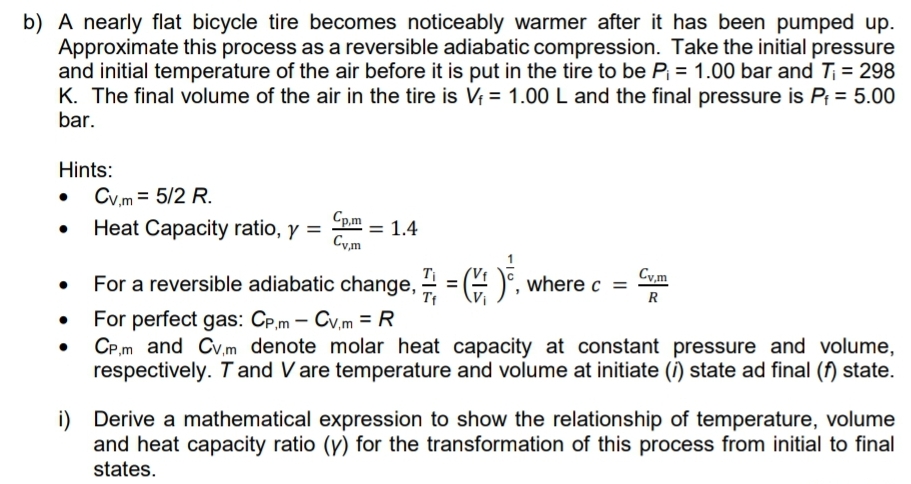b) A nearly flat bicycle tire becomes noticeably warmer after it has been pumped Approximate this process as a reversible adiabatic compression. Take the initial pres and initial temperature of the air before it is put in the tire to be P = 1.00 bar and T = K. The final volume of the air in the tire is V = 1.00 L and the final pressure is P = bar.
b) A nearly flat bicycle tire becomes noticeably warmer after it has been pumped Approximate this process as a reversible adiabatic compression. Take the initial pres and initial temperature of the air before it is put in the tire to be P = 1.00 bar and T = K. The final volume of the air in the tire is V = 1.00 L and the final pressure is P = bar.
Elements Of Electromagnetics
7th Edition
ISBN:9780190698614
Author:Sadiku, Matthew N. O.
Publisher:Sadiku, Matthew N. O.
ChapterMA: Math Assessment
Section: Chapter Questions
Problem 1.1MA
Related questions
Question

Transcribed Image Text:b) A nearly flat bicycle tire becomes noticeably warmer after it has been pumped up.
Approximate this process as a reversible adiabatic compression. Take the initial pressure
and initial temperature of the air before it is put in the tire to be P = 1.00 bar and T; = 298
K. The final volume of the air in the tire is V = 1.00 L and the final pressure is Pf = 5.00
bar.
Hints:
• Cy.m = 5/2 R.
Heat Capacity ratio, y =
Cp.m
Cy,m
= 1.4
%3D
Cy,m
For a reversible adiabatic change, 4 = (4 )°, where c =
R
For perfect gas: CP.m - Cv,m = R
CP.m and Cv.m denote molar heat capacity at constant pressure and volume,
respectively. Tand V are temperature and volume at initiate (i) state ad final (f) state.
i) Derive a mathematical expression to show the relationship of temperature, volume
and heat capacity ratio (y) for the transformation of this process from initial to final
states.
Expert Solution
This question has been solved!
Explore an expertly crafted, step-by-step solution for a thorough understanding of key concepts.
Step by step
Solved in 2 steps with 2 images

Knowledge Booster
Learn more about
Need a deep-dive on the concept behind this application? Look no further. Learn more about this topic, mechanical-engineering and related others by exploring similar questions and additional content below.Recommended textbooks for you

Elements Of Electromagnetics
Mechanical Engineering
ISBN:
9780190698614
Author:
Sadiku, Matthew N. O.
Publisher:
Oxford University Press

Mechanics of Materials (10th Edition)
Mechanical Engineering
ISBN:
9780134319650
Author:
Russell C. Hibbeler
Publisher:
PEARSON

Thermodynamics: An Engineering Approach
Mechanical Engineering
ISBN:
9781259822674
Author:
Yunus A. Cengel Dr., Michael A. Boles
Publisher:
McGraw-Hill Education

Elements Of Electromagnetics
Mechanical Engineering
ISBN:
9780190698614
Author:
Sadiku, Matthew N. O.
Publisher:
Oxford University Press

Mechanics of Materials (10th Edition)
Mechanical Engineering
ISBN:
9780134319650
Author:
Russell C. Hibbeler
Publisher:
PEARSON

Thermodynamics: An Engineering Approach
Mechanical Engineering
ISBN:
9781259822674
Author:
Yunus A. Cengel Dr., Michael A. Boles
Publisher:
McGraw-Hill Education

Control Systems Engineering
Mechanical Engineering
ISBN:
9781118170519
Author:
Norman S. Nise
Publisher:
WILEY

Mechanics of Materials (MindTap Course List)
Mechanical Engineering
ISBN:
9781337093347
Author:
Barry J. Goodno, James M. Gere
Publisher:
Cengage Learning

Engineering Mechanics: Statics
Mechanical Engineering
ISBN:
9781118807330
Author:
James L. Meriam, L. G. Kraige, J. N. Bolton
Publisher:
WILEY